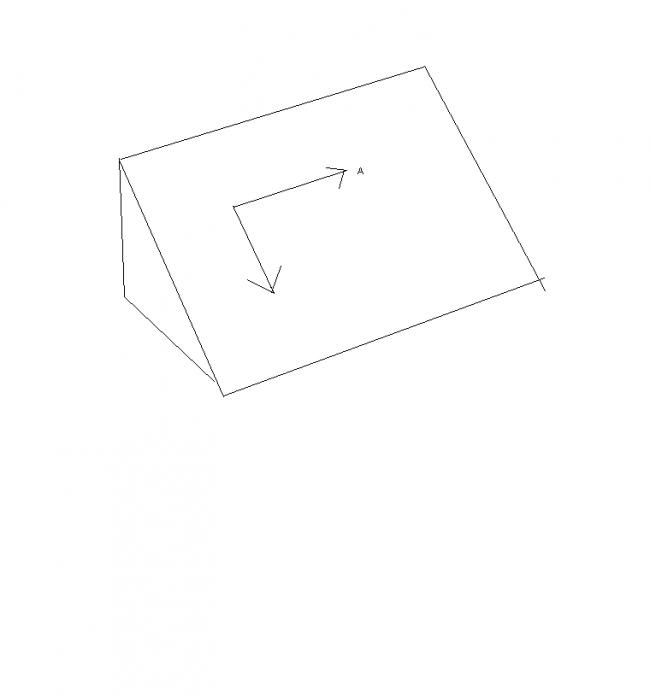 1
1your solution is not clear ..
 9
9terrific work rohan
but you must have waited for another day so that we try to solve
 1
1well here is the two liner solution ..
as we know friction opposes relative motion , friction will always act opposite to the body's velocity
magnitude of frition = μN(as it is moving)=tanθmgcosθ=mgsinθ
finally as subash and asish have pointed out .. the velocity would be straight down the plane ..
because at each moment
let velocity be oriented at an angle of β to the horizontal clockwise .
ax=-Fcosβ
ay=Fsinβ + mgsinθ
as the object moves its velocity along x decreases and y increases therby increasing β
as tiime passes we see that at sufficient β ay surpasses ax and after a long time ax will almost have reduced to zero
(as β increases at infinite time we would have β =90 and thus the net force if you calculate comes to be zero)
thus the object will have a constant veocity at infinite time .
further observe that -
acceleration along velocity = -F+mgsinθsinβ
acceleration along Vy = -Fsinβ +mgsinθ
so
md(vy + v)/dt=-mgsinθ + mgsinθsinβ -mgsinβsinθ +mgsinθ =0
thus the quantity v + vy always remains constant ..
at t=0 the above quantity is = V0 + 0
at infinitely long time when v is vy (no vx)
=v + v
so we have
v+v= V0 + 0
thus v=V0/2
 62
62subash keep trying ... you will enjoy if you solve this one yourself :)
 11
11bhaiyya! can you provide solution or will we have to wait
im not making much progress here
 1
1yes subash and asish the direction given by you is correct ..
 106
106this is what i know of concept but clueless how to convert it to equations...
--> friction acts in a direction opposite to the resultant velocity..
--> initially friction acts opposite to horizontal direction.
--> as time increases and speed down the incline increases... the frictional force continually changes direction and becomes more inclined towards the downward velocity
--> After infinitely long time the frictional force will be directed up the incline.
--> kaymant sir's hint is i think the best way.. let me try it.. now only understood his hint
 11
11is the direction given by me correct?
 66
66yes satan, you are right again.. now the answer to your original question can be easily guessed [1]. but i suggest ppl to first try it themselves before pondering over the answer given by satan
 11
11the direction of the final velocity would be down the plane
because no other force other than friction in the direction A(in your figure)
magnitude still thinking........
 11
11
This is the figure for my solution
 1
1how can u write tana=V/gtsinθ ?
friction will affect both horizontal and vertical velocities !!
 1
1
FINALLY WAS ABLE TO UPLOAD ..
the direction to which i am referring is that one along A (along the plane)
 11
11See
Velocity due to gravity u = tgsinθ
The V and u are at right angle
Resultant velocity is
R2 = V2 + u2
Force due to friction is tanθmgcosθ = mgsinθ
therefore acc due to friction is gsinθ
The resultant velocity = R - gsinθt
Velocity = √(V2 + t2g2sin2θ) -tgsinθ
Limit both of them for t==>∞
 1
1it will be
this is for kaymant sir ..only
v/(1+cosθ)
 66
66good question satan...
Additionally, you guys may try to find the speed of the particle as function of the angle between the instantaneous velocity vector and the line of greatest slope (which is the line perpendicular to the direction of A in figure of #2)
 1
1remember the concepts virang ..
friction opposes relative motion
so intially friction will act opposite to the velocity .. and gravity will act down the plane and hence there will be downward motion ..
 11
11For motion downwards Forces are gravity and friction
Noraml = mg
Friction is tanθmgcosθ = mgsinθ
Force due to gravity
= mgsinθ
Since friction is equal to gravitational pull There will be no downwards motion.
The Body will only move horizontally on the plane and come to rest after T = V/gtanθ
 1
1cmon !! more people should try it!!!
 1
1Thank god!! Well, i'm tryin it...
 1
1nothing at all .. didnt i mention its simple ..
well there may be big ways to do it as u mentioned but the method i am talking about doesnt need these ..
 1
1Infinite time....something to do with limits here? Or integration? Then i might as well leave the job to you or anyone else coz i'm hopeless at that.
 1
1hmm....do we take the components of 'g' ? And then friction also will oppose horizontal as well as vertical motion..
 1
1remember friction opposes relative motion .. :)
 21
21mayb the friction force will also hav to b resolved into 2 components

